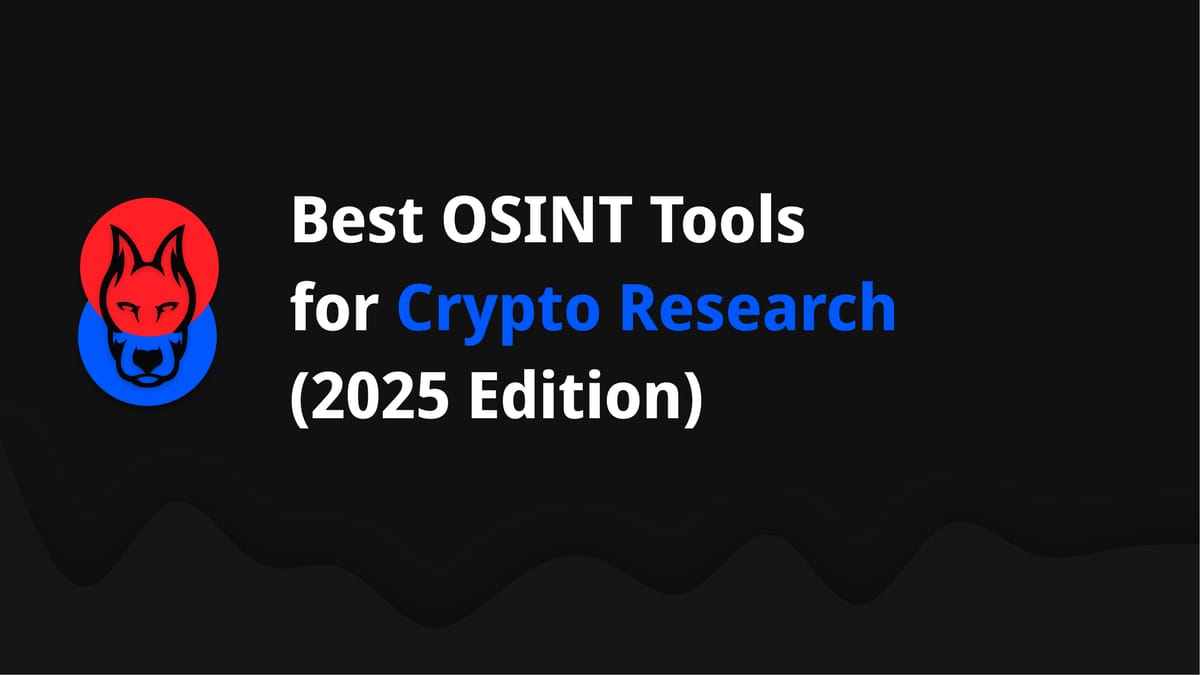Best OSINT Tools for Crypto Research (2025 Edition)

OSINT (open-source intelligence) has become the backbone of modern crypto research.
Analysts, traders, and funds increasingly rely on public data to identify flows, trace wallets, monitor stablecoins, and anticipate market rotations before price reacts.
In this 2025 edition, we review the best OSINT tools for crypto research, grouped into categories:
- Blockchain & On-Chain
- Stablecoins & Flows
- Derivatives & Market Structure
- Macro & Cross-Asset
- General Intelligence & OSINT
- News & Data Feeds
This evergreen guide will help you design a crypto intelligence pipeline: collect → filter → analyze → act.
Blockchain & On-Chain
These tools allow you to trace transactions, analyze addresses, and build entity-based intelligence.
- Etherscan — the most popular Ethereum block explorer. Lets you trace wallet transactions, token transfers, read/write smart contracts.
- Arkham Intelligence — AI-powered entity mapping. Groups wallets by owners (exchanges, funds, whales). Great for “Smart Money” tracking.
- Glassnode — advanced on-chain metrics. Cohort analysis, realized cap, exchange inflows/outflows.
- Nansen — wallet tagging & dashboards. “Smart Money” and institutional portfolio tracking.
- Dune Analytics — SQL-based community dashboards. Thousands of ready-made datasets (DEX flows, NFT volume, DeFi metrics).
- Token Terminal — financial metrics for crypto protocols (P/E, revenue, tokenomics).
- Messari — research platform, governance tracking, curated project data.
Stablecoins & Flows
Stablecoins are the lifeblood of crypto liquidity. These tools help monitor issuance, flows, and capital rotation.
- SoSoValue — ETF flows, net creations/redemptions, provider AUM. Critical for tracking Bitcoin & Ethereum ETFs.
- DeFiLlama – Stablecoins — stablecoin supply dashboards with chain splits and issuer data.
- CoinMetrics — institutional-grade network data, circulating supply, and velocity.
- CryptoQuant — exchange inflows/outflows, stablecoin reserves, miner positions.
- IntoTheBlock — token holder composition, stablecoin velocity, and liquidity analytics.
ETF flows rarely act alone. They compress CME futures basis and trigger ETH/BTC rotation signals. For liquidity context, see our Stablecoin Flows Guide.
Derivatives & Market Structure
To understand flows, you must also track derivatives. Basis, funding rates, and options flows often confirm or invalidate signals.
- CME Group — official futures & options data. Open interest, basis spreads, institutional positioning.
- Skew (Coinbase) — professional derivatives dashboards (volatility surfaces, futures spreads).
- Laevitas — options and derivatives analytics with institutional dashboards.
- Kaiko — institutional API for market data (tick-level trades, liquidity).
- Coinalyze — perp funding, liquidation heatmaps, sentiment charts.
Macro & Cross-Asset
Crypto doesn’t exist in isolation. Monitoring macro and cross-asset flows helps explain volatility.
TradingView — global charting platform, alerts, scripts for cross-asset analysis.
- FRED — Federal Reserve database: CPI, M2, interest rates.
- World Bank Data — macroeconomic datasets for global analysis.
- IMF Data — FX reserves, balance of payments.
- OECD Stats — inflation, trade, and economic indicators.
General Intelligence & OSINT
These are broader intelligence tools often used in cybersecurity and investigations, but very useful for crypto analysts.
- IntelligenceX — search leaked documents, domains, and archived data.
- PublicWWW — search websites by code snippets (e.g., wallet addresses, scripts).
- Shodan — scan internet-facing devices, sometimes linked to exchange nodes.
- Censys — certificate and infra scanning.
- HaveIBeenPwned — check if email/wallet data leaked.
- Maltego — investigation framework for building entity graphs.
News & Data Feeds
Crypto runs on narrative. Monitoring news feeds keeps you ahead of sentiment.
- Inoreader — RSS aggregator with keyword alerts. Great for monitoring 100+ sources.
- GDELT — global event dataset, useful for macro + geopolitical events.
- CryptoPanic — curated crypto news aggregator with sentiment filter.
- Bloomberg Crypto — institutional-level market coverage.
- CoinDesk — leading industry news outlet.
Building Your OSINT Workflow
Now that you know the best OSINT tools for crypto research, the real value comes from combining them into a pipeline:
- Collect: Use RSS (Inoreader) + APIs (CoinMetrics, Glassnode).
- Filter & Automate: Automate with Make.com or Zapier, summarize with GPT-5.
- Analyze: Build dashboards (Dune, TradingView).
- Act: Trigger alerts via Telegram or email when thresholds hit.
This workflow lets you track ETF flows, stablecoin movements, derivatives alignment, and macro shifts before the market reacts.
Conclusion
The crypto intelligence pipeline in 2025 is built on open data.
By combining blockchain explorers, flow analytics, derivatives dashboards, and macro indicators, traders and funds can gain alpha in a 24–48h window before price adjusts.
Build your OSINT edge
👉 Bookmark this list of best OSINT tools 2025 and start building your own crypto OSINT workflow today.
For full strategies and alert schemas, explore:
Doberman VC — Research Notes & Dashboards



